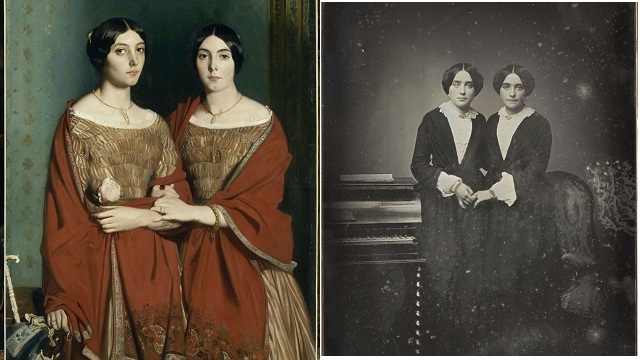PHOTOGRAPHY IN THE SERVICE OF PAINTING Many artists recognized photography as an invaluable aid using the camera directly as a speedy sketching device or using published or commissioned images as visual reference and inspiration. Photography only began to develop in the 19th century so it has a much shorter history than painting.

A New Culture Chapter 9 Section Ppt Video Online Download
In the early stages of photography when the new technique was still widely viewed as an aid to art and science rather than as capable of producing art of its own the use of the camera to provide reproductions of paintings as well as to help the contemporary painter by bringing his work to the attention of a new art purchasing public was both common and well.

. As significantly the development of photography influenced art in the second half of the nineteenth century. How did photography influence the development of painting. The Royal Academy supported the age-old belief that art should be instructive morally uplifting refined inspired by the classical tradition a good reflection of the national culture and above all about beauty.
As photography evolved from a mere mechanical means of reproducing reality to gaining artistic credibility it allowed painters a closer examination of light and asymmetrical cropped spaces as well as an exploration of spontaneity and visual ambiguity. While some artist appreciates the development of photography and embraces the impact towards their own works Get Access. Photographys naturalism in large part produced the impetus for paintings move toward abstraction which gave rise to all the isms that have characterized 20th-century art.
Celebrated nature and dramatic action. They wanted to stir the emotions. In the second half of the nineteenth century photography began to influence artists choice of subject matter because of the mediums ability to take a snapshot of ordinary people doing everyday things.
They wanted to stir the emotions. How if at all did the invention of photography influence the development of modern art. What are three subjects romantics favored.
They were interested in history legends and folklore. Intimately linked to painting through its choice of subject matter its representational idiom but also through the multiplication of the image brought by its dissemination de Font-Réaulx. But trying to keep young nineteenth-century artists eyes on the past became an issue.
How did tehnological advances in transportation and communications affect the industrial revoultion. They were interested in history legends and folklore. Until now photography has a profound influence on paintings ever since optical devices were introduced in the art society.
The realism of photography made some artists turn away from realistic painting. Portable cameras could also be taken outdoors to record landscapes enabling the painting process to be completed in the studio. In the 40s and 50s Jackson Pollock Robert Motherwell and other Abstract Expressionists pushed this trend to the point where painting had left behind representations of the physical world.
Celebrated nature and dramatic action. How did photography influence the development of painting. Of course the upper class did not welcome this act of cheapening art.
Some artists such as. The decisive moment that the photographer chose to click the shutter gives the viewer a window into the subjects world at that second. With the rise of photography access toward portraits became a possibility.
Photography and cameras have had a profound affect on painting starting at least as early as the 15th Century. However from the start photography influenced both the. Chronophotography or what is now referred to as time-lapse photography influenced the development of the work of Cubist and Futurist painters in the early 20th century.
Between painting and photography the largely experimental period in which this developed coincided with the founding of the Pre-Raphaelite Brotherhood. Photographs cannot take pictures of the past so they only focused on what was current visible and tangible. However the concept of photography influencing painting has been very controversial.
The realism of photography made some artists turn away from realistic painting. Realism and the painting of modern life. The cameras influence was apparent in the visual characteristics of paintings the subject matter and the powerful direction in which artists were able to take their creative visions.
British philosopher John Ruskin encouraged the minute observation of nature by artists. Photography in a sense made art cheaper and more accessible to all the layers of society. It allowed artists to record accurately the world around them It allowed artists to focus on concerns other than replicating reality.
It made the artist paint diffrently moree creative beacuse cameras could produce the picture how it was but if they made it slighly diffrent with diffrnt colors and not blening. As an artist you begin to. In the early stages of camera development long exposures with a camera were required to capture the image which created shutter-drag allowing for beautiful fluid movement and gracefully blurred selections.
At the time portraits were expensive and mostly exclusively available to the rich. As a tool a very ancient device called the Camera Obscura Latin for dark chamber or. Paintings by Dante Gabriel Rossetti John Everett Millais and John Singer Sargent are included and personally i believe they are the highlights of the exhibition are shown side by side with the photos they inspired and of.

How Photography Became An Art Form By Aaron Hertzmann Medium

Influence Of Photography On Modern Art Kiama Art Gallery

How Photography Changed Art Seniorcare2share
How The Invention Of Photography Changed Art Pearey Lal Bhawan

How Photography Became An Art Form By Aaron Hertzmann Medium

How Photography Changed Painting And Vice Versa Big Think


0 comments
Post a Comment